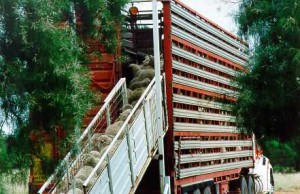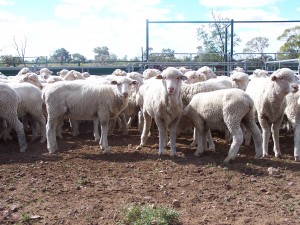 Prime lambs are now being produced in many areas which are a long way to markets and by people new to the sheep industry. This raises the question ‘How do you consign your lambs and sheep so that they arrive in the best possible condition and value?’
Prime lambs are now being produced in many areas which are a long way to markets and by people new to the sheep industry. This raises the question ‘How do you consign your lambs and sheep so that they arrive in the best possible condition and value?’
Tony Dunn, Livestock Buyer for Fletchers International, suggested that the most important thing that producers can do is to lock the lambs off water for 24 hours before trucking. The lambs should be fed as much dry hay as they want during this time. In big herbage years, which this year promises to be for many people, 36 hours is better. Other key points are:
- Know what you are sending, before they travel. Weighing is essential.
- Be on top of what you are sending – draft off the lame and diseased (cancers in older sheep) etc. Especially when sending sheep to a saleyard, as this is just what the animal welfare activists are looking for.
- At the saleyard, presentation is important so that the buyers stop and compete on your pen rather than walking past. For example, Dorpers should be shorn six weeks before consigning. This is not required, if they are going straight to the meatworks.
Rachel and Ranald Noble from ‘Tarbarah’ at Blackall highlighted that preparation for trucking begins well before the lambs and adult sheep go onto the trucks. Good facilities with consistent early handling to produce quiet sheep and lambs, used to handling, are important. Rachel added that:
- They try to have the least amount of stress as possible. Ranald emphasised that they do not use dogs with their Dorper lambs.
- In the yards they have shade, use a Prattley 3-way draft and a Peak Hill Sheep Handler. These ensure less stress to livestock and people.
- Lambs are weighed and drafted well before trucking. Sale lambs are put into a holding or larger paddock, if needed, and re-yarded when required.
- Normally the lambs are yarded the night before and trucked in the morning.
 Olly Gray, Territory Sales Manager for Elders Warwick, also highlighted the importance of locking lambs off water before travelling. He suggested:
Olly Gray, Territory Sales Manager for Elders Warwick, also highlighted the importance of locking lambs off water before travelling. He suggested:
- In summer, lambs should be yarded late in the afternoon, locked off water overnight, loaded first thing in the morning and trucked so that they arrive at the saleyard 24 hours prior to sale.
- At the yards the lambs should be fed good quality hay, preferably Lucerne, and allowed access to water. A dollar spent before the sale is more than rewarded during the sale. Olly has found that if Dorper lambs are given a good feed they will drink readily, fill up and look great. Merinos are a bit harder to get to feed properly.
- In winter you may have to lock up the lambs longer before trucking.
- Woolly stock is an area where a major effort is required. Presentation because of fouling and the extra space required are issues. Shorn, clean stock, either store or fat, are where he would be heading.
Tim Salter, the Manager of Elders in Longreach who has sold many sheep out of the central west, in the last few years, talked about getting the best value for sheep. He highlighted the importance of making the line of sheep as even as possible (either by age or weight). Other key points were:
- To work out the numbers for sale to best suit trucking options.
- To scan ewes prior to sale if joined or if you suspect a straying ram. Scanning is a big positive in selling joined sheep and can also be important at various times and for different markets for dry sheep.
- Pre-trucking protocols and animal husbandry immediately before loading all add to the value of the sheep. Curfews and supplementary feeding pre-loading should be discussed prior to sale and noted in the assessment. This offers reassurance around the professionalism and commitment from the vendors.
Noel O’ Dempsey Leading Sheep South region Coordinator (07) 4653 1441 odempseyn@gmail.com
Joy Hardie Leading Sheep North and Central West Coordinator (07) 4658 7285 jandjhardie@bigpond.com
